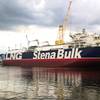McQuilling: Tanker Demand Flat
McQuilling is of the opinion that tanker markets are driven by interactions of supply and demand. While tracing short-term demand remains a constant challenge, long term or annual world demand data provides solid grounds for comparison and analysis of tanker demand on yearly basis. Tanker demand is measured in ton-mile units. Ton miles are achieved when the quantity of tons transported by a vessel is multiplied by the distance carried. The resulting units are commonly used for calculating tonnage demand and are called ton-miles. Below is an example of a simple ton-mile calculation. By calculating total ton-miles on dirty tanker voyages in a given year, we produce a summary of annual dirty tanker demand and break it down into four dirty tanker sectors.
There was essentially no change in 2007 demand in comparison to 2006 in the VLCC sector. The Suezmax and the Aframax dirty sectors showed a slight increase of just below 2% and the demand for dirty Panamax vessels decreased by almost 4% in 2007 / 2006 year-on-year comparison. On average across crude and DPP tanker sectors tanker demand growth was flat in 2007.
No growth in tanker demand in 2007 is a significant drop from 6% growth in 2006. This decrease in demand was essentially the reason for weaker freight rates in the first eleven months of 2007 when compared to 2006. The spike in the tanker freight rates in December, 2007 helped the yearly freight averages achieve similar levels of the previous year. Overall, however, increasing fleet capacity and decreasing demand growth interacted throughout the year and caused relatively low freight levels. Another interesting point to note is the demand fragmentation of tanker sectors. For instance, 86% of VLCC demand came from seven major sector trades in 2007. The Suezmax sector was made up of far more fragmented demand with only 58% of the total demand represented in nine trades. The Aframax sector demand fragmentation was in between the larger two sectors with 71% of demand coming from eight major sector trades. The Panamax sector demand was highly fragmented with only 45% of demand representing four major sector trades.
Lastly, decrease in a Marine Fraction of the total oil demand is another indicator of weakening demand in 2007. The Marine Fraction is a percentage of total world oil demand transported on tankers. In 2007 we measured a decline in Marine Fraction from a high of 57.9% to 57% resulting in almost a full percent drop (more details on this subject available in Weekly Note No. 3). Yearly demand comparisons are a key indicator pointing to the strength of annual tanker market. However, tracing accurate measurements of supply and demand interaction on a short-term basis remains a constant challenge.










